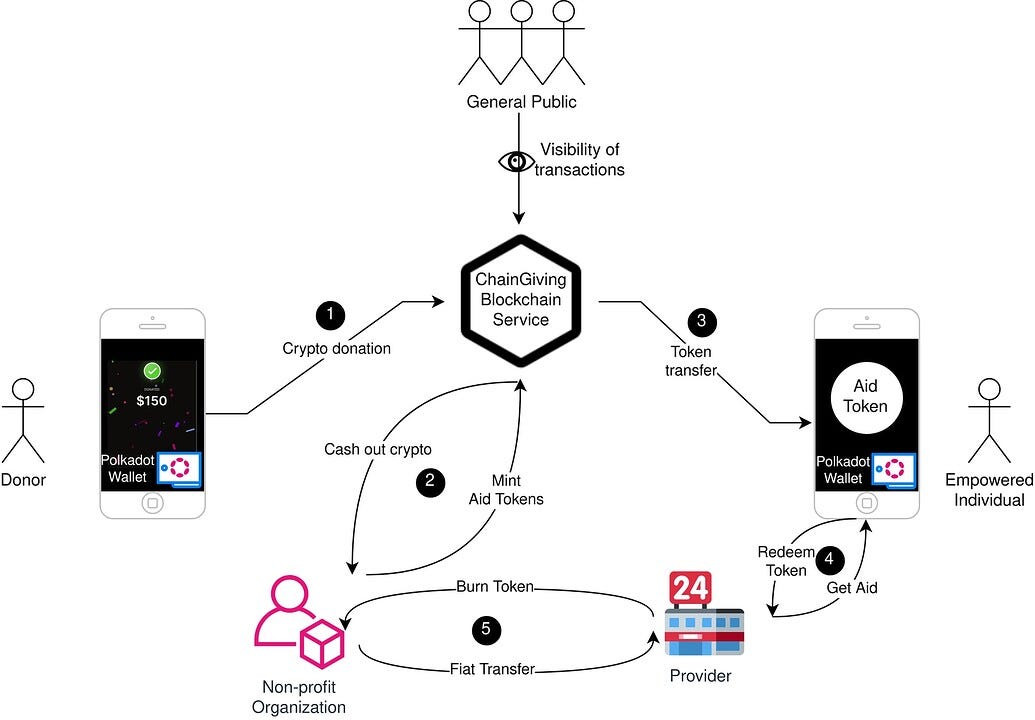Chain.Giving, the Humanitarian Blockchain
In this post: Why do we need a Blockchain for Digital Humanitarian Assistance ? What is Chain.Giving ? What is the current status of the Project ?
Why do we need a Blockchain for Digital Humanitarian Assistance ?
In 2022, Cash and Voucher Assistance (CVA) totaling approximately $10 billion was distributed globally (source: CALP Network). Non-Profit Organizations increasingly recognize the effectiveness of this mode of assistance over traditional in-kind distributions. Moreover, this aid is increasingly delivered via digital methods, such as mobile wallets. This shift presents a remarkable opportunity to increase the scale and expand the reach of global humanitarian assistance.
However, despite digital monetary assistance being proven to be highly effective in delivering aid to those in need, it faces several challenges:
Smaller organizations can struggle with implementation due to a lack of organizational, technological and legal capabilities, especially when operating across international borders.
A significant portion of the global population remains unbanked or undocumented, leading to inequalities to access aid when distributed digitally.
The process lacks transparency for donors who wish to know precisely how their donations are utilized. Indeed, gathering data after the provision of assistance is challenging.
Blockchain technologies can offer solutions to these issues, as evidenced by a number of blockchain-based aid programs deployed by leading humanitarian organizations:
The World Food Program's Building Blocks project (starting in 2017). This is likely the largest and longest-running deployment of its kind, with our team at Parity Technologies involved as the blockchain technology provider.
The Unblocked Cash Project, developed by Consensys for Oxfam in 2019.
The Humanitarian Token Solution from the International Committee of the Red Cross (ICRC), developed by Partisia Blockchain in 2023.
So far, those solutions have been limited to larger organizations and still have a long way to reach large scale adoption. This is why we identify the opportunity to offer an open and decentralized solution: a public Humanitarian Blockchain accessible to organizations of all sizes. This blockchain, paired with a suite of open-source tools (such as a mobile wallet, a donor portal, and a token distribution back-office), has the potential to establish an effective global solution for humanitarian assistance.
What is Chain.Giving ?
Chain.Giving is a public blockchain initiative designed to provide a comprehensive toolkit for Non-Profit Organizations (NPOs) to deliver Digital Humanitarian Assistance. At its launch, the platform will feature two primary functions: a crowdfunding module and an aid token distribution module.
The crowdfunding module enables NPOs to raise funds through cryptocurrency donations, allowing them to receive contributions from around the world while eliminating delays and costs associated with traditional money transfers.
The aid token distribution module empowers NPOs to create assistance programs using digital tokens. This feature provides NPOs with the tools to generate their own tailor-made fungible or non-fungible tokens to create anything from digital vouchers to proofs of participation.
Crucially, by conducting both crowdfunding and aid distribution on the same blockchain, Chain.Giving can closely link these two aspects. This ensures that donor funds for a specific program are directly tied to the corresponding aid programs. It also enhances transparency for donors and the public, while expediting the delivery of aid.
To explain the different user journeys and the flow of actions within the Chain.Giving platform, we propose the following diagram which is decomposed in five distinct steps.
A donor equipped with their cryptocurrency wallet can contribute to various crowdfunding programs established by NPOs on the platform. Each program sets a donation target and specifies the recipients of "Aid tokens". These tokens, issued by the NPO, represent entitlements to goods or services.
When the donation target is reached, the NPO initiates the minting (creation) of these tokens and transfers the donated cryptocurrency to their wallet. This process occurs simultaneously and transparently, visible to all.
Upon receipt, end-users find aid tokens in their wallets. These tokens could be fungible (like a food voucher) or non-fungible (evidence of program participation) and are immediately usable. The transparency of blockchain transactions allows the public to track this activity in real-time.
End-users can then visit a participating provider (e.g., a local supermarket collaborating with the NPO) and redeem their tokens in exchange for the program’s goods or services using the Chain.Giving mobile wallet.
Periodically, local aid providers trigger the burning (destruction) of program tokens and receive fiat currency from the NPO.
What is the current status of the project ?
Chain.Giving is currently in the launch phase, where the Minimum Viable Product (MVP) requirements and milestones have been established. The team is prepared to commence implementation as soon as seed funding is secured. We are confident that we possess the necessary expertise to build an MVP and are enthusiastic about demonstrating our solution to organizations, delving into how it can best address their specific use cases.
What’s next?
We encourage you to join us on the journey of Chain.Giving as we embark on our launch phase. Your support is crucial in bringing our vision to life. Stay informed and be part of the movement:
Chat with us on Discord
Follow @chain_giving on Twitter
Become a volunteer:
If you're passionate about making a difference, consider joining our team as a volunteer. Your skills and dedication can contribute to the success of Chain.Giving. Sign up using this form to express your interest and be an integral part of our mission.




